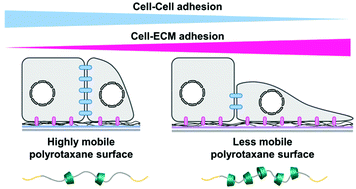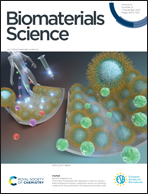Improved epithelial cell–cell adhesion using molecular mobility of supramolecular surfaces
Abstract
Cells can sense the surrounding microenvironmental properties including contact with biomaterials. Although in vitro cell fates in response to the physical properties of cell-adhesive materials have been widely reported, their influence on cell–cell adhesion is unclear. Here, we investigated the role of molecular mobility on polyrotaxane surfaces in epithelial cell–cell adhesion. Polyrotaxane surfaces with high mobility induced cytoplasmic yes-associated protein (YAP) localization in epithelial cells, whereas those with low mobility induced nuclear YAP localization, suggesting that YAP localization is switched by the mobility of the polyrotaxane surface. The cytoplasmic YAP localization increased the expression of tight junction-associated genes. A scratch assay revealed that although the epithelial cells on the low mobile surface rapidly initiated their migration, the cells on the highly mobile surface delayed their migration. Thus, this finding suggests that polyrotaxane surfaces with higher mobility induce cytoplasmic YAP localization, leading to stronger cell–cell adhesion. The polyrotaxane biointerface is promising as a powerful tool to improve the physical immune system and repair biological tissues.



 Please wait while we load your content...
Please wait while we load your content...